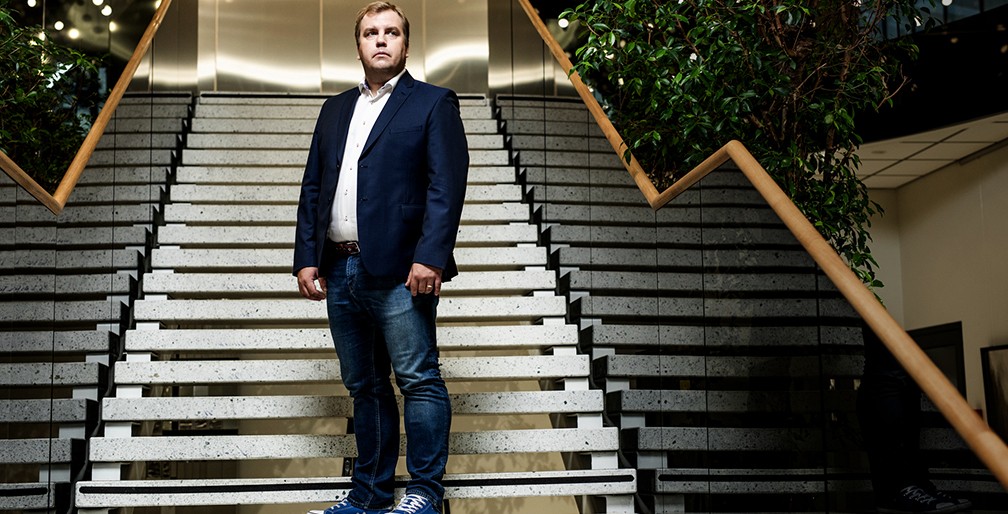Since it emerged from the Soviet bloc, this Baltic nation of 1.3 million people has been determined to define what government should look like in a digital world. Like a scrappy startup taking a risk on a disruptive new business model to seize first-mover advantage, Estonia embraced change early and never looked back. It did not wait for a larger country with deeper pockets to prove the value of, say, online voting. It defined the cutting edge, strengthening its economy and building a global tech reputation in the process. Executives mulling a transformation—or struggling to complete one—can see in Estonia how deep and lasting change happens.
The country has set the bar for next-gen government in the digital age—and its leaders aim to push it higher. At birth, Estonians are given a digital ID they will carry throughout their lives, which can be used for every transaction with the government. Some 99 percent of all government services can be accessed online. With an Internet connection, Estonians can order prescriptions (the state has socialized medicine), pay taxes and vote. Indeed, there are only three things Estonians cannot do digitally: Buy real estate, get married and get divorced. “For those things, you still have to show up in person so we can make sure you’re not being coerced,” jokes Siim Sikkut, Government CIO in the Ministry of Economic Affairs and Communications of Estonia.
It may seem like the government has completed its digital transformation. In June the government completed work on the world’s first “data embassy”—a facility in Luxembourg that backs up troves of sensitive data to help keep vital services running in the event of a cybersecurity attack or natural disaster inside Estonia.
Yet on his first day as CIO in March 2017, Mr. Sikkut tweeted that “there’s still lots to do.” His job is clear: Keep pushing for innovations so Estonia does not lose the technological lead it has worked so hard to build. This mission requires Mr. Sikkut to play two roles. Primarily, he is an evangelist for further technological advancement in what has come to be called “e-Estonia,” creating and helping to executive a cutting-edge digital agenda across the government. But he also acts as a bridge between government and the private sector, rolling out the welcome mat to companies looking for a place to innovate at scale with, say, autonomous vehicles.
There is plenty of overlap between the two roles. For example, the country’s “e-residency” program, which Mr. Sikkut helped take live, allows foreigners to conduct business worldwide as if they were from Estonia. The hope is to lure business owners to set up shop in Estonia and drive economic growth. Estonia markets itself as a “hassle-free environment for business and entrepreneurship,” and it is actively recruiting companies to set up shop and take advantage of the digital economy it is creating. It seems to be working: By some estimates, Estonia has more startup companies per capita—most in tech—than anywhere else in the world.
For Mr. Sikkut, pushing the ongoing digital transformation forward is nothing less than a matter of survival. ““I think,” he says, “that creating and improving our digital society is really our shot in the world,” Share on X he says.
“You can get almost everything done digitally today in Estonia. But the question now is, why do you have to even do them yourself? If we add a bit of automation and analytics, we can do things for you. They can happen in the background.” —Siim Sikkut, Government CIO in the Ministry of Economic Affairs and Communications of Estonia
Experiment, Then Scale Up
 A central goal of Estonia’s digital effort is to make the country a magnet. The more convenient it is for residents to interact with government, the more likely it is they will stick around and others might move there. That is particularly important in today’s business landscape where the war for talent is fierce, and small countries like Estonia must compete against the entire European Union (EU), where workers can easily move across borders.
A central goal of Estonia’s digital effort is to make the country a magnet. The more convenient it is for residents to interact with government, the more likely it is they will stick around and others might move there. That is particularly important in today’s business landscape where the war for talent is fierce, and small countries like Estonia must compete against the entire European Union (EU), where workers can easily move across borders.
One of Mr. Sikkut’s main management challenges is convincing policymakers to keep innovating even though Estonia’s government is already deeply digitized. “In Estonia, every ministry is a digital ministry,” he says. “I can’t just drive innovation from my own team, from the technology side. We have to also encourage innovation ideas to come from the people who will actually build government systems and use the new technologies.”
And when the innovative idea is coming from Mr. Sikkut’s team, he has to carefully build support for change. For example, if he is trying to convince the country’s tax minister that a new suite of artificial intelligence (AI) software will improve his agency’s interaction with companies, Mr. Sikkut’s approach is to get that minister on board with change first by showing the advantages to be gained. From there, he hopes ministers will become evangelists for change.
“There’s always some kind of resistance. People here in Estonia don’t mind digital change. But they may have resistance against change as such: If they have to do something on a process level differently tomorrow, they need convincing or incentivizing about why they should.”
Another approach Mr. Sikkut has taken is to look for small initiatives that can be quickly implemented and scaled up if successful. “That is hard for many of our policy colleagues to understand,” he says. “They would prefer to develop a complete system, to have every detail worked out before it is introduced. But we can’t afford complexity. That’s been hard learning for us. We have been relentless in going forward, but we can’t go after big bangs and get everything together from launch. We want to try the ‘start small, fail fast’ approach to innovation within government.”
That is the approach Mr. Sikkut took with the e-residency program he rolled out during the last few years. For about €100, anyone in the world can now become virtual citizens—or e-residents—of Estonia, which grants them access to most of the same digital services that actual Estonians have. E-residents are given government-issued IDs, can open financial services accounts, sign things digitally and register companies in Estonia. There is no requirement to have a physical presence in the country.
The goal is to take advantage of the world’s burgeoning digital freelance workforce, members of which make up 41 percent of Estonia’s e-residents, according to Medium. Famous e-residents hoping to learn from Estonia’s trailblazing experiment include Japanese Prime Minister Shinzo Abe, venture capitalist Tim Draper and German Chancellor Angela Merkel.
“Basically, we don’t make enough babies, so we thought we could grow digitally,” Mr. Sikkut says.
Still, he was not sure the program would catch on. But when the government received hundreds of applications within the first few months, his team scaled up the e-residency platform. Today, there are 45,000 approved e-residents of Estonia. Those new residents have established 6,000 new businesses—all of which have access to the European Union market.
“We want to do more things like that,” Mr. Sikkut says. “Put something in place, scale it on the go if it works and stop if it doesn’t.”
Support for that kind of experimentation from the nation’s top leaders has been crucial. “In Estonia, we’ve had enormous luck in that political leaders have been very open to taking risks if the benefits outweigh the risks. That changes the way you think about what you can do.”
Proving Ground
Another thing top government leaders have been open to is achieving innovation through private-sector partnerships. Mr. Sikkut is not shy about this. “We are a small country. We never have the illusion that we can do things just by ourselves,” he says.
“I think that creating and improving our digital society is really our shot in the world.”
—Siim Sikkut
As he ramps up his efforts to automate more government services, Mr. Sikkut’s top priority is to introduce AI tools into e-Estonia. He has made an open call to AI firms around the world that want to test their platforms using an entire country as a proving ground.
“We’re offering our government, our country, as a testbed for anyone working on AI. We want to be safe and secure, of course. But a company working on AI can still have the chance to try out things here faster and on a national scale—things you probably could not try out anywhere else.”
For example, last year the country became the first in the EU to allow Starship Technologies’ six-wheeled robots to roam sidewalks delivering takeout and grocery orders. The Estonian government has offered a similar opportunity to companies in the autonomous vehicle market; last year it opened all of its roads to companies that want to test driverless technology. It has a strategic goal of developing a fleet of vehicles that can be used for public services.
AI tools could similarly create a more efficient digital government, one where Estonian citizens and bureaucrats require even less interaction than they have today. “You can get almost everything done digitally today in Estonia,” Mr. Sikkut says. “But the question now is, why do you have to even do them yourself? If we add a bit of automation and analytics, we can do things for you. They can happen in the background.”
One example: At age 63, all Estonians are eligible for a government pension. To receive it they have to apply online. Only 1 percent of eligible pensioners do not apply. Mr. Sikkut hopes that, soon, no one will need to apply at all. Instead, an AI-backed system will simply start making pension payments to all citizens when they turn 63.
“We see there are ways that we can get predictive like that, and thus more effective in our policies and services,” he says. “We really have been way too slow in making use of massive amounts of data.”
Conquer the World, From Estonia
As CIO, it also falls to Mr. Sikkut to boost the robust startup scene in Estonia’s capital, Tallinn. That scene was spawned in part by the e-Estonia movement, but it is also a product of homegrown successes like Skype, which was founded there in 2003. “Skype taught us that you can conquer the world, even from Estonia,” he says.
From a policy perspective, Mr. Sikkut is working to help Estonian companies more easily work with others in the EU. For example, Mr. Sikkut and other government leaders have been working since Estonia’s EU Council presidency last year to engage all EU countries in the exchange of more data in support of the “once only” principle. “That means that if one member state knows something about me, the other member state should not ask me this again,” Mr. Sikkut told EURACTIV Slovakia. “That would force us to integrate more.”
He is also hoping to bolster private companies in Estonia by offering them the chance to assist his government in overhauling procurement practices to make them more transparent and efficient. It is a win-win approach: Mr. Sikkut gets to know as many tech business owners as he can, helping them better access foreign markets. In exchange, he finds business owners who can further improve the government’s digital services.
“To drive these kinds of changes, you have to be relentless. We Estonians have been relentless in making changes one by one. As a nation, by staying committed, we have achieved a lot. That is important: Even if the changes are small, keep making them. Keep going.”






